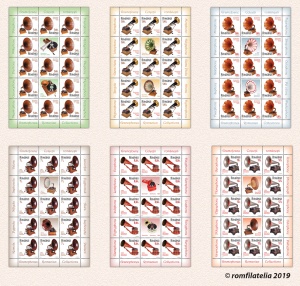Romfilatelia continues the series of Romanian Collections postage stamp issues, this time with the topic Gramophones. The issue, which will be introduced into circulation on Thursday, 12th of December, current year, consists of six stamps and an imperforated souvenir sheet, on which Gramophones of different types and historical periods meant to illustrate the development of phonic reproduction technology. These exhibits belong to a prestigious collection from Bucharest, the greatest in the world, certified by Guinness World Records, in 2016.
On the postage stamp with the face value of Lei 1.40, is represented a Wooden horn gramophone. This piece is spectacular due to the size of its wooden horn. Made from oak, the horn provides a pleasant tone as well as a generous volume. The motor is engaged through a spring. This gramophone was manufactured in 1908 and sold in France and Germany.
The Brass horn gramophone is illustrated on the postage stamp with the face value of Lei 1.60. Manufactured by the Columbia Company in the United States of America, it is referred to as a “disk graphophone”, from the name of the device developed by Alexander Graham Bell in pursuit of improving on Edison’s phonograph. This device operates with a disk and sports a sliding tone-arm, decorated and engraved with the company’s name. The brass horn is specific to this type of device and connected directly to the reproducer.
On the postage stamp with the face value of Lei 1.80 is depicted a Veneer horn gramophone. Named a “Parlophone”, it was manufactured in Germany, in 1910. The box that conceals the motor is decorated with three brass plates that illustrate a battle scene from Antiquity. The veneer horn bears the shape of flower petals, amplifying and spreading sound throughout the chamber.
The postage stamp with the face value of Lei 7 illustrates the Hot-air-operated gramophone. Manufactured in Switzerland by Paillard, in 1907. This gramophone operates in an unusual way as it disk is not employed by and electric or arch operated motor but rather by a hot-air-operated motor. The box is fitted with a funnel on the side through which air is pulled in by the motor, passing through a flame maintained by a spirit-lamp. The ingenious way in which this gramophone is built shows the mastery of its producer. The motor is an unusual one and the way in which the box is manufactured in order for the flame to not damage the components or the wood is in its own right remarkable.
The postage stamp with the face value of Lei 8.50 reproduces the image of a Child gramophone with chocolate disk. In 1903 the German company Stollwerck created limited series of gramophones for children that had the feature of using chocolate disks. The sound was imprinted on these special disks to then be rendered with these gramophones. The fragility of these pieces and especially the disks have made these gramophones exceptionally rare today, those of the colour red being the rarest variant.
The Coin-operated salon gramophone is represented on the postage stamp with the face value of Lei 12. These were used in restaurants and hotels that were often crowded. Their size is larger than that of a normal gramophone because the sound needed to be sufficiently amplified to overlap the voices of the crowd as well as other background noise. The use of the gramophone was engaged by inserting a coin into the special slot, the base of the machine concealing a drawer where coins would collect. The metal horn produced a strong and clear sound and the wooden box that concealed the mechanism was very beautifully ornated.
On the postage stamp of the imperforated souvenir sheet of the issue, with the face value of Lei 28.50 is depicted a gramophone of impressive proportions having 2 m and 18 cm in height, meant for very large and even open spaces. The immense horn, sporting a diameter of 85 cm, produced a powerful and clear sound, capable of overlapping background noise and people’s voices. Due to it being coin-operated, it was necessary for these to be inserted in the slot for the turntable to spin. Once the reproducer reached the end of the disk, the mechanism would stop and revert to its starting position. The wooden box concealed a vast space meant to store disks. Manufactured in Germany in 1910 it was even then an impressive piece of equipment.




